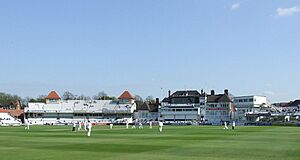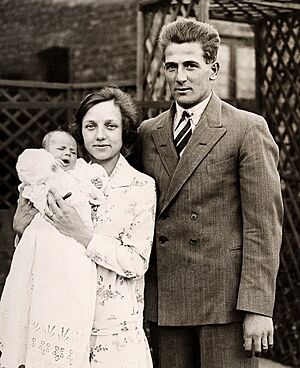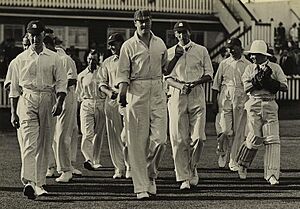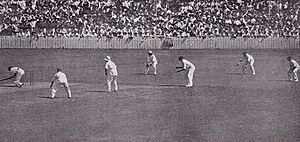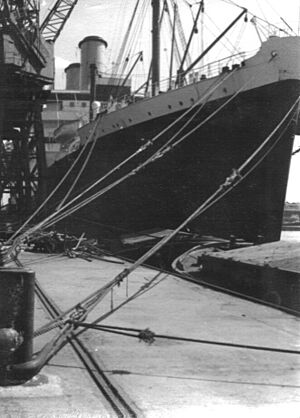Harold Larwood facts for kids
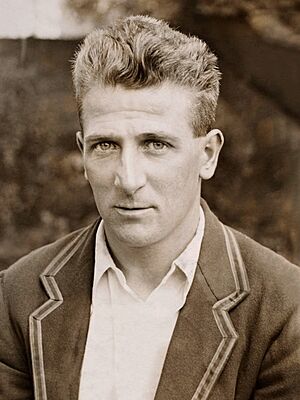
Larwood on a 1932 cigarette card
|
||||||||||||||||||||||||||||||||||||||||
| Personal information | ||||||||||||||||||||||||||||||||||||||||
|---|---|---|---|---|---|---|---|---|---|---|---|---|---|---|---|---|---|---|---|---|---|---|---|---|---|---|---|---|---|---|---|---|---|---|---|---|---|---|---|---|
| Full name |
Harold Larwood
|
|||||||||||||||||||||||||||||||||||||||
| Born | 14 November 1904 Nuncargate, Nottinghamshire, England |
|||||||||||||||||||||||||||||||||||||||
| Died | 22 July 1995 (aged 90) Randwick, New South Wales, Australia |
|||||||||||||||||||||||||||||||||||||||
| Nickname | The Wrecker | |||||||||||||||||||||||||||||||||||||||
| Height | 5 ft 8 in (1.73 m) | |||||||||||||||||||||||||||||||||||||||
| Batting | Right-handed | |||||||||||||||||||||||||||||||||||||||
| Bowling | Right arm fast | |||||||||||||||||||||||||||||||||||||||
| International information | ||||||||||||||||||||||||||||||||||||||||
| National side | ||||||||||||||||||||||||||||||||||||||||
| Test debut (cap 225) | 26 June 1926 v Australia | |||||||||||||||||||||||||||||||||||||||
| Last Test | 28 February 1933 v Australia | |||||||||||||||||||||||||||||||||||||||
| Domestic team information | ||||||||||||||||||||||||||||||||||||||||
| Years | Team | |||||||||||||||||||||||||||||||||||||||
| 1924–1938 | Nottinghamshire | |||||||||||||||||||||||||||||||||||||||
| 1936/37 | Europeans (India) | |||||||||||||||||||||||||||||||||||||||
| Career statistics | ||||||||||||||||||||||||||||||||||||||||
|
||||||||||||||||||||||||||||||||||||||||
|
Source: ESPNcricinfo, 8 January 2009
|
||||||||||||||||||||||||||||||||||||||||
Harold Larwood (born November 14, 1904 – died July 22, 1995) was a famous professional cricketer from England. He played for Nottinghamshire County Cricket Club and the England cricket team from 1924 to 1938. Harold was a right-arm fast bowler. He was known for his incredible speed and accuracy. Many people thought he was the fastest bowler of his time, and even one of the fastest ever!
Harold was the main player in a special bowling style called "bodyline". This style caused a lot of arguments during England's cricket tour of Australia in 1932–33. Because of this, his international career ended earlier than expected.
Harold grew up as a coal miner's son and started working in the mines when he was 14. He quickly became a top bowler for Nottinghamshire. He played his first Test match in 1926. He was part of the team that won the Ashes in Australia in 1928–29.
However, the Australian batsman Don Bradman became very dominant. Harold and other bowlers struggled against him in 1930. After this, England's captain, Douglas Jardine, developed the fast leg theory (bodyline) bowling attack. Harold was the main bowler for this tactic. It worked very well in the 1932–33 Test series in Australia.
The Australians said this method was "unsportsmanlike". This caused problems between the two countries. Harold refused to apologize for his bowling, as he was just following his captain's orders. He never played for England after that tour. But he continued to play very successfully for his county team for several more years.
Years later, in 1949, Harold became an honorary member of the MCC (Marylebone Cricket Club). In 1950, he and his family moved to Australia. He was welcomed there, unlike during his playing days. He worked for a soft drinks company and sometimes reported on cricket matches. He visited England several times, and a stand at his old cricket ground, Trent Bridge, was named after him. In 1993, at 88, he received an award called the Member of the Order of the British Empire (MBE) for his services to cricket. He passed away two years later.
Contents
Early Life and Cricket Start
Harold Larwood was born on November 14, 1904. He grew up in a village called Nuncargate in Nottinghamshire, England. This area was close to a coal mining town. He was one of five sons. His father, Robert Larwood, was a miner and loved playing cricket for the village team.
Harold went to Kirkby Woodhouse school. This small school produced five international cricketers, including Harold. After leaving school at 13, Harold worked at a local shop. The next year, he started working in the mines with pit ponies.
Harold showed a talent for cricket early on. He started playing for Nuncargate's second team in 1918. Even though he was playing against adults, he took 76 wickets in his first season. By 1920, he was playing for the first team alongside his father. He played in simple canvas shoes because his family could not afford proper cricket boots.
Becoming a County Player
Even though Harold was short (only 5 feet 4 inches at 18), he was very strong from working in the mine. He could bowl incredibly fast. Joe Hardstaff senior, a famous Nottinghamshire and England cricketer, noticed Harold's talent. Hardstaff suggested that Harold try out for the county team.
In April 1923, Harold and his father went to Trent Bridge for the trial.
At first, Harold did not bowl well. But as he gained confidence, his bowling got much better. The county committee members were impressed. They offered him a contract to play. Harold accepted right away. He would earn the same as his mining wages, and also help with ground duties. He was eager to leave the mine.
In 1923, Harold worked on getting stronger and improving his bowling skills. He grew a few inches taller and gained weight. He practiced constantly to improve his accuracy and learn how to make the ball swing in the air. He played for the county's Second XI team. In one match, he took 8 wickets for 44 runs.
Harold played his first full county match on August 20, 1924. It was against Northamptonshire. He took one wicket in the game. He felt he was "not ready," but his coach, James Iremonger, disagreed. The county captain, Arthur Carr, also believed Harold would become a future Test bowler. Carr helped Harold a lot throughout his career.
Harold's next county match was in June 1925 against Yorkshire. He took three wickets, including that of famous batsman Herbert Sutcliffe. After this, he became a regular player for Nottinghamshire. He finished the season with 73 wickets. He also showed skill as a batsman, scoring 70 runs in one game.
Playing for England
First Test Matches
Harold started the 1926 county season well. He took the wicket of Jack Hobbs, England's best batsman, twice in one match. Hobbs was very influential with the national selectors. The Australians were in England to play for the Ashes. Hobbs thought Harold was good enough for England. This led to Harold playing in a "Test Trial" match in June.
Harold took five wickets in the trial match. He was then chosen for the second Test against Australia, starting on June 26. He was nervous, but Captain Carr told him he was ready.
The Test match was a draw. Harold took three important wickets. He felt his performance "wasn't great." He was not chosen for the next two Tests. For the final match, Percy Chapman became England's captain. Harold was called back for this important game. England won the match and secured the Ashes for the first time since 1912. Harold took 3 wickets for 34 runs. Many people praised his performance.
In the 1926 season, Harold took 137 wickets. He also scored 451 runs. No Test matches were played in 1927. Harold's performance for Nottinghamshire made him the top bowler in the country. He took 100 wickets and was named one of the five Wisden Cricketers of the Year. Nottinghamshire finished second in the County Championship. In 1927, Bill Voce, another ex-miner, joined the Nottinghamshire team. He later became Harold's main fast bowling partner. At the end of the season, Harold married Lois Bird.
In 1928, Harold played in two Tests against the West Indies. He took six wickets. For Nottinghamshire, he took 138 wickets, again leading the national bowling averages. He also scored his first century (100 runs) as a batsman.
Touring Australia in 1928–29
Harold was an obvious choice for the England team that toured Australia in 1928–29. In an early game, he took 7 wickets and scored 79 runs. He dismissed Australian batsman Bill Ponsford. Ponsford had said Harold was "not really fast." Later, in the second Test, a fast ball from Harold broke a bone in Ponsford's hand.
England won the first Test by a huge margin. Harold took 6 wickets for 32 runs. His bowling was described as "faster than I have ever seen him." This bowling helped England win the series. England won four out of five matches. Harold took 18 wickets in the Test series. He also scored 367 runs.
Harold sometimes used a tactic called leg theory. This meant bowling towards the batsman's legs with many fielders on that side. Australian former bowler Arthur Mailey noticed this. The crowds in Australia sometimes booed Harold. He said, "I got called every name you can imagine."
Facing Don Bradman in 1930
Back in England in 1929, Harold played three Tests against South Africa. He took eight wickets. He was injured during the third Test and missed some games. His bowling figures were not as good as in previous years. However, he and Bill Voce helped Nottinghamshire win the County Championship.
In 1930, the Australians visited England. England won the first Test. Harold's participation was cut short by illness. He took 2 wickets.
Because of his illness, Harold missed the second Test. Australia scored a record 729 runs, with Don Bradman scoring 254. Australia won this game. Harold returned for the third Test. He later said his first ball to Bradman was a bouncer that touched the bat and was caught. But the umpire said "not out." Bradman went on to score 334 runs. Harold took one wicket for 139 runs. England saved the game because of rain.
Harold was dropped for the fourth Test. He was recalled for the final Test. Australia scored 695 runs (Bradman 232) and won the series. Harold took one wicket, Bradman's, but it cost 132 runs. He admitted Bradman had "pasted me unmercifully." Cricket experts realized that something new was needed to stop Bradman.
Planning for Bodyline
Harold had a good season in 1930, taking 99 wickets. He also batted well. He was not chosen for the 1930–31 tour of South Africa. For the next two years, he focused on county cricket. He was the top bowler in 1931 and 1932. In 1932, he took 162 wickets, his best season ever. Despite this, he thought he had little chance for the 1932–33 tour to Australia because of his poor Test record against Bradman. But he was selected, along with Bill Voce.
In 1931, Douglas Jardine became England's captain. He wanted a strategy to challenge Australia. Jardine and others thought Bradman disliked fast, rising balls. One such ball from Harold had hit Bradman in the chest. This gave Jardine an idea: a continuous attack of fast leg theory bowling. This might make Bradman and other Australian batsmen uncomfortable.
Leg theory bowling was not new. Harold and Voce had used it before for short times. But Jardine planned a continuous attack towards the leg stump. He would place many fielders close on the leg side to catch any shots. Harold and Voce agreed to try this tactic. Harold said, "I had no doubt of its purpose: we thought Don was frightened of sharp rising balls."
Harold and Voce tried these tactics in county matches. Two batsmen were injured. Spectators were confused by how ineffective the bowling seemed at times. But experts believed it would be different on Australia's faster pitches.
The Bodyline Tour, 1932–33
The England team sailed to Australia on September 17, 1932. There were four fast bowlers: Harold, Voce, Bill Bowes, and G.O. "Gubby" Allen. Pelham Warner was the team manager.
The fast leg theory attack was first used in a match against an Australian XI (including Bradman) on November 18. Harold dismissed Bradman for low scores in both innings. He later wrote that it was "refreshing" to see Bradman struggling. Jack Hobbs, now a reporter, thought the bowling had shaken Bradman's confidence. The English tactics upset the crowds.
The first Test began on December 2, 1932. Bradman was ill and did not play. England won by 10 wickets. Harold took 10 wickets for 124 runs. Australia's Stan McCabe scored 187 runs, attacking both types of bowling. During this match, a reporter used the word "bodyline" to describe England's leg theory bowling. This term quickly became popular in Australia.
The second Test started on December 30. The pitch was slower, which made England's fast bowling less effective. Harold also had sore feet. Bradman returned and scored a century, leading Australia to victory. Many thought fast leg theory would not work anymore. The series was tied 1–1.
The third Test began on January 13, 1933. It was a very unpleasant match. Bill Woodfull, the Australian captain, was hit over the heart by a ball from Harold. He was hurt for several minutes. When Woodfull continued, Jardine switched to the leg theory attack, which angered the crowd. Harold then knocked Woodfull's bat out of his hands. Later, a ball from Harold hit Bert Oldfield on the head, forcing him to leave the game. The crowd was very angry. Harold thought they might invade the field.
England won the match. Harold took seven wickets. While the game was still on, the Australian Board of Control sent a message to the MCC, saying England's tactics were unsportsmanlike. The MCC rejected this and demanded they take back the accusation. The argument became a big diplomatic issue. It was decided the matter would go to the Imperial Cricket Conference (ICC). Jardine said he would not play another Test unless the "unsportsmanlike" charge was removed. The Australian Board later clarified that they still disliked bodyline, but did not question the English team's sportsmanship.
In the fourth Test, England won and kept the Ashes. Harold used less bodyline bowling. The match was calm. Harold received a telegram from Archie Jackson, an Australian player who was ill, congratulating him. Harold kept this telegram for the rest of his life. In the final Test, Harold was hit in the left foot. He could no longer bowl. But Jardine made him stay on the field while Bradman was batting, believing his presence would still affect Bradman. England won the series 4–1.
Harold's injury ended his tour. He returned to England. He was England's most successful bowler in the Tests, taking 33 wickets. He also scored 145 runs.
After the Bodyline Tour
End of Test Career
When Harold returned home, he was not allowed to speak to the press until the rest of the team arrived. On May 7, 1933, he defended "leg theory" in a newspaper article. He said Woodfull was too slow and Bradman was too scared. He also criticized the Australian crowds. He wrote a book called Bodyline? where he talked more about Australian batting failures and crowd behavior.
Harold's foot injury meant he barely bowled in 1933. But he was so popular that Nottinghamshire still played him as a batsman. Meanwhile, Australia banned bodyline bowling. The MCC eventually agreed not to use bodyline in the 1934 tour.
By 1934, Harold was fit again. He was expected to play in the Tests. However, the MCC decided Harold should apologize to the Australians for his bowling. Harold refused, saying he only followed his captain's instructions. He wrote in a newspaper that he would not apologize and doubted he would play against Australia again. This ended his Test career. Wisden, a famous cricket publication, said that Harold's public statements were a "disservice" to English cricket.
Harold continued to play for Nottinghamshire for several more seasons. He had great success, taking many wickets. In 1936, his benefit season (a special season where a player gets money from ticket sales), he took 119 wickets. Denis Compton, a future Test batsman, said Harold and Voce were the most accurate fast bowlers he ever faced. Harold's relations with Nottinghamshire worsened after his captain, Arthur Carr, was removed in 1934. His foot injury returned, along with a knee injury. In 1938, he left the county and retired from first-class cricket. In his career, he took 1,427 wickets and scored 7,290 runs. In Tests, he took 78 wickets and scored 485 runs.
Later Life and Legacy
Life in England and Australia
After retiring from cricket, Harold worked as a gardener. In 1946, he bought a sweet shop. He usually stayed away from public attention. But he attended a farewell lunch for Don Bradman in 1948. He and Bradman were polite to each other. The next year, Harold became an honorary member of the MCC. He said this helped heal the hurt he felt from how he was treated earlier.
Life was hard in post-war Britain, and Harold's shop did not make much money. His former opponent, Jack Fingleton, convinced him that he would find better opportunities in Australia. On April 1, 1950, Harold and his family, including five daughters, sailed to Australia. They received a warm welcome. The former prime minister, Ben Chifley, even secretly paid half their hotel bills. The family settled in Sydney, and Harold found a job with a soft drinks company.
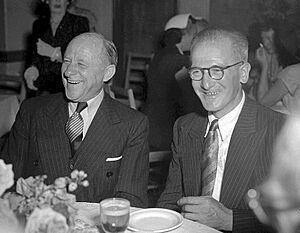
Harold sometimes wrote or commented on cricket for newspapers and radio. At first, English touring teams were suspicious of him. But from the 1960s, England players often visited him. He sometimes met Don Bradman at cricket events. Their relationship remained polite but distant.
In 1977, Harold attended the Centenary Test match in Melbourne. He later called it "one of the best days of my life." His presence created a lot of interest among cricket fans. He visited England several times, his last trip being in 1980. In 1982, the 50th anniversary of the bodyline series brought back some negative attention and hate mail for Harold.
Final Years and Passing
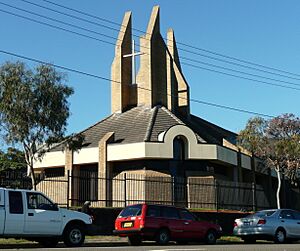
As he got older, Harold often shared his opinions on cricket. He disliked the protective gear used in the 1970s. He also thought Ian Botham, an England player, was overrated. He was not impressed by the 1984 Australian TV show Bodyline, saying it was inaccurate and might bring back bad feelings.
In 1985, he became an honorary life member of the Sydney Cricket Ground. In England, the Larwood and Voce Stand was opened at Trent Bridge. In June 1993, Harold was awarded an MBE for his contributions to cricket. A newspaper said, "At last the ruling classes honour the man who carried the can for their savage arrogance."
In his last years, Harold changed his mind about Bradman being scared. He recognized Bradman as the greatest batsman ever. Harold gradually lost his sight but remained sharp. On his 90th birthday, he played garden cricket with his great-grandchildren. He passed away in hospital on July 22, 1995, at 90 years old. He was cremated, and his ashes were placed in a memorial wall at Holy Trinity Anglican Church in Kingsford. His wife Lois passed away in 2001, and her ashes were placed next to his.
Bowling Style and Impact
Harold Larwood is widely seen as the greatest fast bowler of his time. His Wisden obituary said he was "one of the rare fast bowlers... to spread terror in opposition ranks." Technology was not advanced then, but tests showed his bowling speeds were between 90 and 100 miles per hour.
Harold was short for a fast bowler, but he had long arms. His bowling action was smooth and powerful. Neville Cardus, a cricket writer, called it "absolutely classical." Facing Harold at his fastest was like a "public stoning," according to his biographer. Jack Hobbs said Harold was not only the fastest but also the most accurate bowler he had ever seen. Later fast bowlers, like Australia's Ray Lindwall, copied Harold's action.
Harold said he did not try to hit batsmen. But he admitted he "didn't shed any crocodile tears if a batsman was hit." In 1990, he said he might have bowled at a batsman's ribs, but never at their head. However, he did cause serious injuries to opponents. Many suffered bruises and minor fractures. After the bodyline series, a song in Australia described how scared batsmen felt:
With a prayer and a curse they prepare for the hearse,
Undertakers look on with broad grins.
Oh, they'd be a lot calmer in Ned Kelly's armour
When Larwood the wrecker begins.


